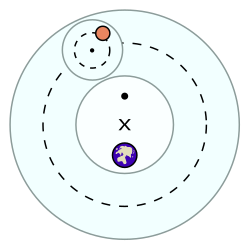
Equant (or punctum aequans) is a mathematical concept developed by Claudius Ptolemy in the 2nd century AD to account for the observed motion of the planets. The equant is used to explain the observed speed change in different stages of the planetary orbit. This planetary concept allowed Ptolemy to keep the theory of uniform circular motion alive by stating that the path of heavenly bodies was uniform around one point and circular around another point.
Ptolemy does not have a word for the equant – he used expressions such as "the eccentre producing the mean motion".[1]
- ^ Claudius Ptolemy. The Almagest (PDF). Translated by G.J. Toomer.